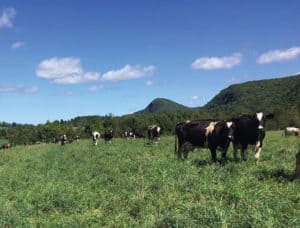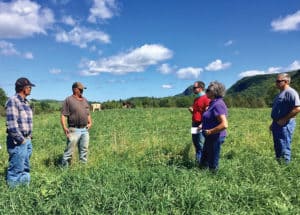By Cheryl Cesario
Editor’s note: Cheryl Cesario is a grazing specialist with University of Vermont Extension from Middlebury. She received a Northeast Dairy Business Innovation Center grant to develop a pilot dairy grazing cohort group, which provides direct one-on-one technical assistance and farmer-to-farmer learning opportunities. The Clevelands are one of five farms participating in the project.
A few years ago Scott Cleveland decided to seed down 65 acres of his best corn ground. It was 2018 and he had just signed a Natural Resources Conservation Service contract to install the necessary infrastructure to implement a rotational grazing system on these newly seeded fields.

Scott and Traci Cleveland operate Cleveland Farm in Pawlet.
His farm is in Pawlet, in the Mettawee Valley where the soil produces some of the highest corn crop yields in the state. What his motivation was for doing this? His answer was simple: If he could grow great corn here, he knew he could grow the best pasture crop for his cows as well.
Cleveland Farm was established in 1985 and has been at its current location since 1994. Scott Cleveland and his wife, Traci, run the farm together, along with their eldest son, Justin, who is on the farm full-time. They ship the milk from their 80 milking cows to AgriMark/Cabot.
While Cleveland’s main motivation in transitioning to a grazing-based operation was to find a more economical way to produce milk by reducing feed costs, he had some initial hesitations.
“I was worried it was going to be too time consuming and that we weren’t going to gain enough benefits from it,” he explained.
By September 2019, he had installed all of the fencing, laneways and water system as outlined in his contract. When representatives from the Natural Resources Conservation Service came to see the finished results, he laughed and said, “So now what happens?”
It is said that the journey of 1,000 miles begins with one step, but that first step can be the most difficult. For Cleveland, like most, it was critical that he get this right. He didn’t have room for error.

By grazing their cows on pasture during the summer months, the Cleveland’s have seen significant savings in stored feed costs.
He roughly measured out paddock sizes and with the Conservation Service discussed where polywire subdivisions might go. But the real key to success was going to be leaving at least a 4-inch post-grazing residual height, as well as maintaining adequate recovery periods between grazings. These two things are critical in preventing overgrazing damage and keeping the pasture yields productive.
A lot of farmers who transition to grazing feel like they are “wasting feed” when the cows don’t mow the field down like a hay mower would. However, pushing the cows to do so can be a recipe for disaster.
“One of the hardest things was to leave the residual,” Cleveland pointed out. “It’s hard to change that mentality. It’s not like a lawn. I was amazed at the recovery.”
The two months of grazing at the end of the 2019 growing season gave him the confidence to move into the 2020 season full steam ahead.
Last year brought challenges, of course, and like many dairy farmers he had a period of time where he was dumping milk and trying not to overproduce. However, his successes with grazing have been phenomenal, especially for someone in their first full year adapting to a new management system.
By comparing the rations during the grazing and non-grazing seasons, the Conservation Service determined that his herd was obtaining 64% of their daily dry matter intake (DMI) from pasture during the months of May, June, August, September and well into October.
In July, the dry weather conditions really slowed down pasture growth. Cleveland adapted accordingly and utilized a hilltop pasture as a sacrifice area and increased his stored feed ration, while decreasing pasture intake to 28% DMI. This shift was critical in preserving pasture forage yields for the remainder of the season.

Scott Cleveland (second from left) led a grazing discussion group at his farm to share his experience with transitioning to a grazing-based operation to produce milk more economically by reducing feed costs.
Through all of this, his average milk production maintained at 65 pounds per cow. Based on current rates, the Conservation Service was able to estimate the dollar savings per week of each feed type: grain, corn silage, haylage and baleage. In every month but July, Scott saved an estimated $1,570 per week by having his cows harvest their own feed on pasture. In July, that savings dropped to $644 per week. However, there is no doubt that if he hadn’t adjusted the ration during the driest part of the summer, his overall savings would have been drastically reduced. In total, it was estimated that the Clevelands saved $34,000 in stored feed costs over a 25-week period.
Savings also were realized in animal healthcare-related expenses, particularly with hoof health. Based on this, the dairyman figures a return on his initial infrastructure investment by early in the 2021 grazing season.
“I’m very pleased with how this went. I should have done this 10 years ago,” he said.
What’s Cleveland’s vision moving forward?
He says he’s thinking about introducing more shorthorn or Jersey genetics into his herd for their compatibility with his new system. He’s also looking at his farm in a new way, thinking of where else he could be grazing.
“The more you have fenced, the more options you have,” Scott said, explaining that it gives him the flexibility to crop or graze every field in proximity to his barn. Grazing the cover crops on his cornfields is another goal that could provide a few additional weeks on pasture and add to the above totals.
Scott summarized, “It was worth the effort.”




